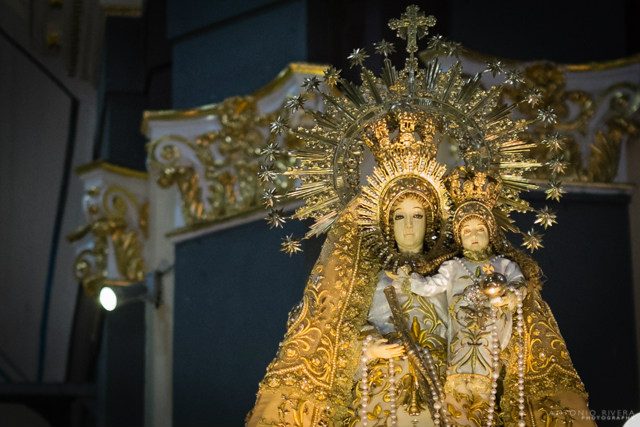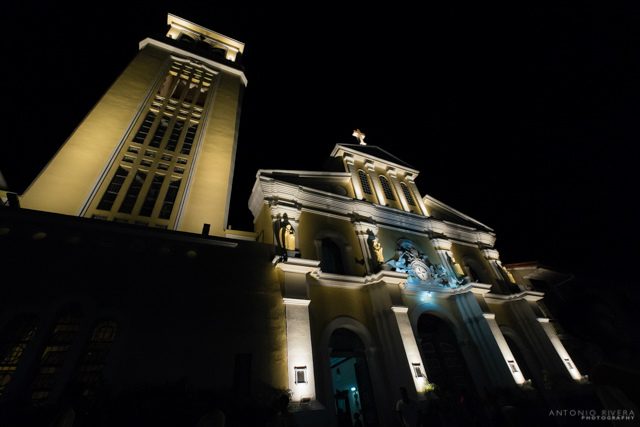SUMMARY
This is AI generated summarization, which may have errors. For context, always refer to the full article.

PANGASINAN, Philippines – The statues of two pillars of the Catholic Church, apostles Peter and Paul, came first in a line of 40 saints that ushered me into Manaoag Shrine for the first time.
It was Tuesday, February 17, in the place they call the “pilgrim center of the north.”
On this day, the Shrine of Our Lady of the Rosary of Manaoag was making its debut as a basilica. This title meant the Pope is granting special privileges to the church and its churchgoers.
I came here to cover the main event. It was, after all, a Mass led by 3 of the Philippines’ 4 cardinals, and joined by the Vatican’s ambassador and the local archbishop. (READ: Tagle on Manaoag Basilica: ‘With honor comes mission’)
I also wanted to understand the kind of faith that makes Filipinos run to the Lady of Manaoag, known here as Apo Baket. Why do they pray? Why do they cry? Why do Filipinos engage in devotions like this – visiting the Black Nazarene, praying the rosary, joining processions?
‘I can vent problems here’
Inside Manaoag Shrine, 3 people helped me understand these forms of devotion.
Connie Reyes, 51, comes from a poor family.
She said it is a sacrifice to come here from the Philippines’ capital, Manila, which is 3 to 4 hours away. She spent P630 for the entire trip.
I asked her, “Are you a devotee?” She cried almost immediately.
Connie’s devotion began 4 years ago, after doctors removed a tumor in her uterus. She attributed her healing to Apo Baket.
Through the years, she has also asked Apo Baket to help her family.
Connie sheds more tears as she remembers her poor relatives, one of whom became a drug addict.
“It feels different to be in a place like this,” she said in Filipino. “It comforts me that I’m able to vent my problems here, especially about my siblings whose needs I cannot fill. So I pray that God might help them, because they themselves cannot come here.”
‘If not through their graces…’
Like Connie, Betty Soriano, a 59-year-old housewife, said she also comes from a poor family. Her father and father-in-law, in fact, both worked as farmers.
While her husband is a lawyer, it strained their finances to send their 6 children to school. Praying the rosary every day, she always ran to Apo Baket for help. She and her husband eventually produced 6 professionals: two lawyers, a priest, a pharmacist, a commerce graduate, and a medical intern.
She recalled in tears: “Our children studied all at the same time. We almost couldn’t pay their tuition fees. Then my husband got sick. I had no one else to ask for help other than the Blessed Mother.”

Unlike Connie and Betty, 80-year-old Fil Zamuco lived a more comfortable life.
Before he retired “at an early age,” Fil worked at the Philippine National Bank.
He now shuttles back and forth from Manila to Baguio, and occasionally drops by Manaoag. He visits this church to thank God and the Blessed Mother. He also prays for his family’s health.
“I’m not probably in this kind of life if not through their graces,” he said.
Pilgrimage, tears, thanksgiving
Why do devotees flock to Manaoag? From my conversations with Connie, Betty, and Fil, 3 things stood out:
First, it’s a pilgrimage.
Second, it’s a deeply spiritual experience that can even drive them to tears.
Third, it’s a form of thanksgiving.
Theologians have a word for the kind of faith that drives these devotees: “popular piety.”
The bishops of Latin America and the Carribean wrote extensively on this in a landmark document after their 5th general conference in 2007. Then Buenos Aires Archbishop Jorge Mario Cardinal Bergoglio, now Pope Francis, headed the group that produced this concluding document. (Francis himself is known as a man of popular piety.)
The bishops praised popular piety as a “people’s Catholicism.” Quoting Pope Paul VI, they said it “manifests a thirst for God which only the simple and poor can know.”
The Latin American and Carribean bishops highlighted pilgrimages – like the ones done in Manaoag. “There, the believer celebrates the joy of feeling surrounded by myriad brothers and sisters, journeying together toward God who awaits them.”
The bishops said: “The pilgrim’s gaze rests on an image that symbolizes God’s affection and closeness….The confident prayer, flowing sincerely, is the best expression of a heart that has relinquished self-sufficiency, recognizing that alone it can do nothing. A living spiritual experience is compressed into a brief moment.”
Warning against ‘distortions of religion’
True, there’s a danger in popular piety.
The Second Plenary Council of the the Philippines (PCP II), a key gathering of Filipino bishops in 1991, warned against popular piety becoming “distortions of religion” or remaining “at superficial forms of worship.”
This would happen when “the saints and the Blessed Virgin Mary seem to preoccupy the attention of many of the faithful more than Christ does.” PCP II said, “our pastoral practice must ensure that the Catholic religion does not become saint- or Mary-centered but that it always remains Christ-centered.”
There’s a bigger danger, however, in dismissing popular piety altogether. This is a tendency among Filipino theologians educated abroad, Jesuit priest Fr Catalino Arevalo said in 2013.
Arevalo, known as the dean of Filipino theologians and also a devotee of the Sacred Heart of Jesus, pointed out that popular piety is “the purest form of inculturation” or rooting Christianity in Filipino culture. This is because popular piety “does not come from above down” but “from below up.”
To spread the Catholic faith in Asia, after all, the right approach “is not primarily cerebral.” Stressing that Asian bishops have consistently said this, Arevalo explained: “The use of the intellect, the use of the brains, the teaching of the doctrines, all that is indispensable and necessary, but…with the Asians, you have to start with the stories, the songs, the symbols, the heart.”
The Latin American and Carribean bishops also defended popular piety, which – while “a personal encounter with the Lord” – “includes much of the bodily, the perceptible, the symbolic, and people’s most concrete needs.”
“It is a spirituality incarnated in the culture of the lowly, which is not thereby less spiritual, but is so in another manner.” – Rappler.com
Add a comment
How does this make you feel?
There are no comments yet. Add your comment to start the conversation.